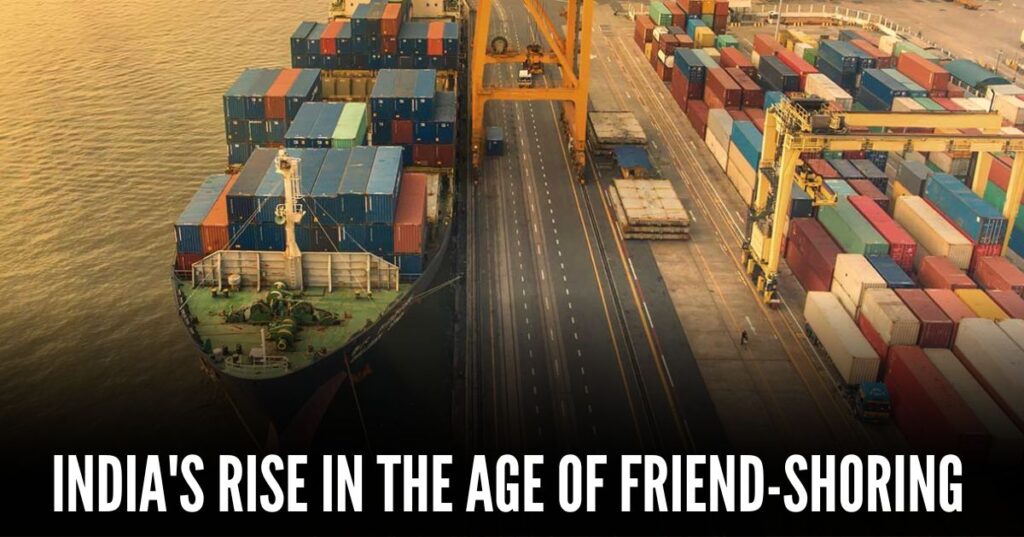
Table of Contents
In recent years, global companies have been reevaluating their production and supply chains due to geopolitical tensions with China. This shift has created an emerging trend called “friend-shoring,” where companies are favouring countries like India over China. In this article, we will explore the potential benefits that India could enjoy as the US pushes for friend-shoring. While India’s IT and service sectors have already experienced significant growth, the realignment of global supply chains could open up new opportunities for India’s manufacturing sector. Let’s delve into the evidence and factors that support India’s potential as a friend-shoring destination and indias rise in the age of friend shoring.
Friend-shoring Gains Momentum:
The concept of friend-shoring is gaining traction as companies increasingly look to diversify their production and supply chains away from China. Several high-profile reports have highlighted the plans of global companies to expand their production capacity in India. For example, Apple intends to shift 25% of its iPhone production to India by 2025, a significant increase from the current 6%. Samsung also plans to invest $356 billion over five years, creating 80,000 jobs in India’s semiconductor and biopharma sectors. Vedanta, Foxconn, Lockheed Martin, and Tata have also announced substantial investments in India.
These plans indicate a growing interest in friend-shoring, particularly in sensitive industries such as semiconductors, defense, and electronics. While these investments are still in the pipeline, the intentions expressed by these global companies underscore India’s potential as an attractive alternative to China.
Foreign Direct Investment (FDI) Trends:
To understand the reality of friend-shoring, let’s examine India’s foreign direct investment (FDI) trends. In the past seven years, FDI into India has exceeded that into China in five of those years. However, this was mainly due to a decline in Chinese FDI that began around the global financial crisis. India’s inward FDI has remained stable at around 1.5-2% of GDP since 2006, indicating limited evidence of friend-shoring.
However, a closer look at India’s inward FDI by origin reveals some interesting patterns. The share of FDI from Western countries increased from 30% to 50% after the election of Donald Trump. This additional investment from the West may have come at the expense of other countries, as global companies sought alternatives to China. Surveys conducted by the American Chamber of Commerce in Shanghai also indicate that a small percentage of companies have considered shifting operations from China, with Southeast Asia often being favored over India.
India’s Alignment with the US:
India’s growing geopolitical influence has enabled it to maintain a historic unaligned stance in tensions between the US and Russia. However, when it comes to the US-China divide, India is likely to align with the US. This alignment is driven by India’s shared security interests with the US in limiting China’s power and influence. As companies seek to move their supply chains away from China, India is well-positioned to benefit further from friend-shoring if it strengthens its ties with the US.
Apple’s decision to relocate more of its manufacturing from China to India, along with the increasing iPhone production in India, demonstrates the potential for enhanced ties. Apple CEO Tim Cook’s recent meeting with Prime Minister Narendra Modi raises hopes for closer cooperation. Furthermore, India’s strategic cooperation with the United States, Australia, and Japan in the Indo-Pacific region strengthens its alignment with the United States.
Economic Prospects and Structural Reforms in India:
India’s long-term economic prospects are bright, given the country’s enormous population potential as the world’s most populated. Because of its enormous labor supply, cost advantages, and progress in structural reforms, India stands to benefit from friend-shoring manufacturing supply chains.
India’s efficient payment system has the potential to create a flourishing online business ecosystem. The recent agreement between the United States and India to expand cooperation in developing semiconductor supply chains, including knowledge exchange, research and development, and labor coordination, demonstrates mutual enthusiasm for helping these enterprises.
Furthermore, India’s consistent success in enacting structural changes, cultivating a business-friendly environment, and developing a qualified workforce are characteristics that make it an appealing investment location. Because of its huge population potential and strategic linkages, India is well-positioned to capitalize on the changing dynamics of global supply chains and emerge as a prominent player in the outsourcing trend.
Benefits for Indian Manufacturers/Exporters:
Numerous reports highlight global companies’ plans to expand their production capacity in India, bringing significant advantages for Indian manufacturers and exporters.
Increased Investments:
Companies like Apple, Samsung, Vedanta, Foxconn, Lockheed Martin, and Tata have announced substantial investments in India, indicating a growing interest in friend-shoring. These investments open up opportunities for Indian manufacturers and exporters to establish partnerships and supply chains with global companies, leading to increased business prospects and export potential.
Industry Expansion:
Sectors such as semiconductors, defense, and electronics are particularly poised to benefit from friend-shoring. With investments from global companies in these sensitive industries, Indian manufacturers and exporters can enhance their capabilities and gain a competitive edge. This expansion can lead to job creation, technology transfer, and the development of specialized skills, fostering further growth in the manufacturing and export sectors.
Market Access:
Friendshoring with the US and other Western countries provides Indian manufacturers and exporters with improved access to global markets. By aligning with multinational corporations and leveraging their distribution networks, Indian businesses can tap into new customer bases and increase their export volumes. This expanded market access can drive revenue growth and boost the overall competitiveness of Indian manufacturers and exporters.
Technology Transfer and Knowledge Exchange:
Collaborating with global companies in friend-shoring initiatives brings opportunities for technology transfer and knowledge exchange. Indian manufacturers and exporters can benefit from advanced manufacturing techniques, research and development partnerships, and access to cutting-edge technologies. This transfer of expertise can enhance productivity, product quality, and innovation capabilities, positioning Indian businesses as high-value players in the global market.
Conclusion:
As geopolitical tensions between the US and China continue to shape global trade dynamics, India has the opportunity to reap substantial benefits as the US pushes for friend-shoring. With investments from global companies in sectors like semiconductors, defense, and electronics, India’s manufacturing capabilities can strengthen and diversify. By aligning with the US and bolstering ties with multinational corporations, particularly in the technology industry, India can solidify its position as a friend-shoring destination.
However, it is crucial to acknowledge that friend-shoring is still in its early stages, and the actual impact on India’s economy will depend on various geopolitical and economic factors. India must continue to enhance its attractiveness as an investment destination by implementing further structural reforms, fostering a business-friendly environment, and nurturing a skilled workforce. With its immense demographic potential and strategic partnerships, India is well-positioned to navigate the evolving landscape of global supply chains and emerge as a key beneficiary of the friend-shoring trend.







